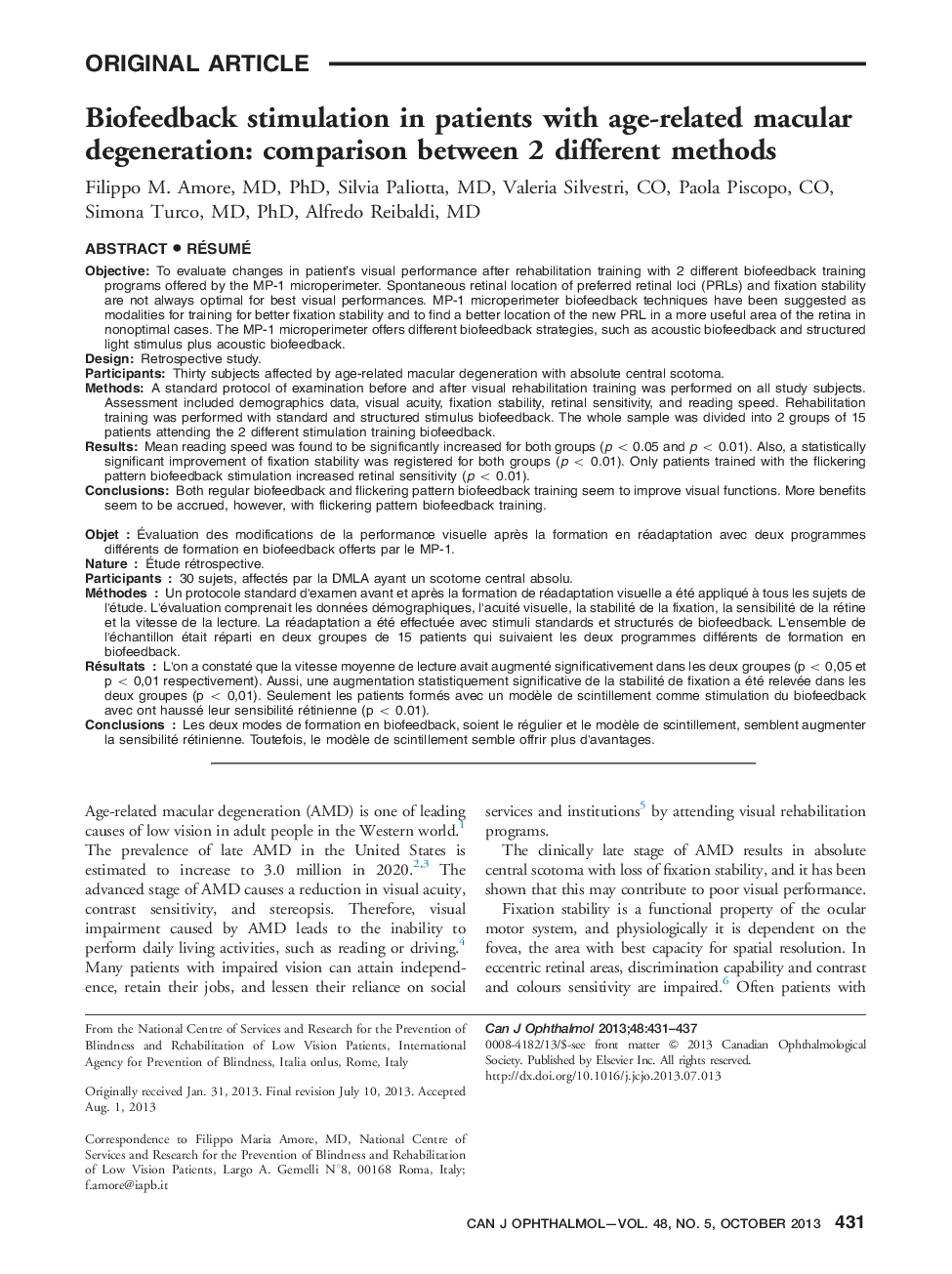| کد مقاله | کد نشریه | سال انتشار | مقاله انگلیسی | نسخه تمام متن |
|---|---|---|---|---|
| 4009470 | 1602407 | 2013 | 7 صفحه PDF | دانلود رایگان |

ObjectiveTo evaluate changes in patient’s visual performance after rehabilitation training with 2 different biofeedback training programs offered by the MP-1 microperimeter. Spontaneous retinal location of preferred retinal loci (PRLs) and fixation stability are not always optimal for best visual performances. MP-1 microperimeter biofeedback techniques have been suggested as modalities for training for better fixation stability and to find a better location of the new PRL in a more useful area of the retina in nonoptimal cases. The MP-1 microperimeter offers different biofeedback strategies, such as acoustic biofeedback and structured light stimulus plus acoustic biofeedback.DesignRetrospective study.ParticipantsThirty subjects affected by age-related macular degeneration with absolute central scotoma.MethodsA standard protocol of examination before and after visual rehabilitation training was performed on all study subjects. Assessment included demographics data, visual acuity, fixation stability, retinal sensitivity, and reading speed. Rehabilitation training was performed with standard and structured stimulus biofeedback. The whole sample was divided into 2 groups of 15 patients attending the 2 different stimulation training biofeedback.ResultsMean reading speed was found to be significantly increased for both groups (p < 0.05 and p < 0.01). Also, a statistically significant improvement of fixation stability was registered for both groups (p < 0.01). Only patients trained with the flickering pattern biofeedback stimulation increased retinal sensitivity (p < 0.01).ConclusionsBoth regular biofeedback and flickering pattern biofeedback training seem to improve visual functions. More benefits seem to be accrued, however, with flickering pattern biofeedback training.
RésuméObjetÉvaluation des modifications de la performance visuelle après la formation en réadaptation avec deux programmes différents de formation en biofeedback offerts par le MP-1.NatureÉtude rétrospective.Participants30 sujets, affectés par la DMLA ayant un scotome central absolu.MéthodesUn protocole standard d'examen avant et après la formation de réadaptation visuelle a été appliqué à tous les sujets de l'étude. L'évaluation comprenait les données démographiques, l'acuité visuelle, la stabilité de la fixation, la sensibilité de la rétine et la vitesse de la lecture. La réadaptation a été effectuée avec stimuli standards et structurés de biofeedback. L'ensemble de l'échantillon était réparti en deux groupes de 15 patients qui suivaient les deux programmes différents de formation en biofeedback.RésultatsL'on a constaté que la vitesse moyenne de lecture avait augmenté significativement dans les deux groupes (p < 0,05 et p < 0,01 respectivement). Aussi, une augmentation statistiquement significative de la stabilité de fixation a été relevée dans les deux groupes (p < 0,01). Seulement les patients formés avec un modèle de scintillement comme stimulation du biofeedback avec ont haussé leur sensibilité rétinienne (p < 0.01).ConclusionsLes deux modes de formation en biofeedback, soient le régulier et le modèle de scintillement, semblent augmenter la sensibilité rétinienne. Toutefois, le modèle de scintillement semble offrir plus d'avantages.
Journal: Canadian Journal of Ophthalmology / Journal Canadien d'Ophtalmologie - Volume 48, Issue 5, October 2013, Pages 431–437